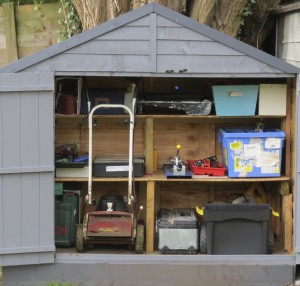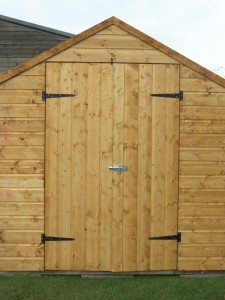Buying a shed
Buying a shed is an almost inevitable undertaking for every homeowner. I’ve put up a number of shed types in my time, and after each construction, I always find myself standing back at the end of the job and on the one hand admiring the fact that you can put up a watertight building in a few hours, but on the other hand feeling a little concerned about how long it will last – let’s face it, flat pack sheds aren’t made out of seasoned prime timber. The question is therefore, how cheap can you really go? To be honest, with a little extra embellishment, I think you can go really cheap as the difference between a budget shed (sub £300) and the pricier models of around the £500 mark, is not a lot in terms of structural integrity, in my opinion. Before I give you my conclusions on the best options, first a little bit more about deciding on construction type and size, which along with price are the essential considerations when buying a shed.
Shed construction
 The main two shed construction types are overlap and shiplap.
The main two shed construction types are overlap and shiplap.
- Overlap – As the name suggests, the construction simply has each horizontal board overlapping the next.
- Shiplap -Â Â This is a tongue and groove construction (see right) which is slightly stronger than an overlap shed, as you have an effective joint between each board.
Is it therefore vital to have the shiplap construction? No, I really don’t think so, as manufacturers have managed to reduce the thickness of the tongue and groove so much, that I don’t believe there is that much more structural integrity. Opting for shiplap is therefore preferable, but not essential at the ‘budget’ shed level.
The two most common roof types are apex (pointy) and pent (slightly sloping flat roof). Apex are by far the most popular as they’re generally cheaper, and you get the extra head room down the middle of the shed. However, some pent designs will give you excellent headroom across the complete width and length of the shed, so it’s always worth looking at the exact heights in the shed details to check it’s suitable for you. Apart from that, it really comes down to aesthetics, as both are efficient designs for shedding water.
Shed size
We can all fill a shed three times over as soon as it’s up, but also, we’ve all got to be realistic. An 8ftx6ft shed is the optimum size for most of us, because you can fit all the standard garden items in, whilst still being able to get in the door.
Double doors always provide better access, but are not essential. However, I’d always go for some windows along one side, not to be pretty, just to allow some light in to make it easier to see what you’re doing.
One vital, and often overlooked area of the whole ‘buying a shed project’ is the subject of the shed base. Do not, under any circumstances, build the shed directly onto the ground, whether it be concrete or grass. You must get it off the ground to get a bit of air circulation under it, and stop the floor getting damp. As a minimum, at least put the shed on slabs. Ideally, use slabs, lay lengths of 100mm x 50mm (4in x 2in) treated timber across these, and then put the shed on these ‘bearers’. It’s not going to add much to the expense of the overall build and will significantly extend the life of the shed.

Bike store sheds, as they’re known, can also be shelved out to provide a very efficient garden storage option.
If space really is an issue, and you need something a little smaller, then consider one of the smaller ‘bike store’ designs. After all, it’s cheaper, makes efficient use of space and is much easier to tuck away in a corner of your garden.
The option shown to the right, I found to be excellent value for money, and with a bit of shelving out, it can indeed store a lot of kit. This particular model is available at Wilkinsons (the grey stain was added after!). I’m not saying it’s the sturdiest construction in the world, but for the price, and after the overall strengthening as a result of the shelving, I’d thoroughly recommend it as a compact garden storage system.
My shed choice
For me, the best option for an affordable garden shed is to go for the budget lines, but then to spend a little extra on ‘beefing up’ the design. All sheds need shelving out to a certain extent, and therefore by buying £30-50 of timber in addition to your shed, you can construct some wall to wall shelving that will both add utility as well as bracing the whole structure.
As mentioned in my introduction, even if you go up to the £500 shed bracket, I don’t think you find a whole lot of difference in overall quality, so for the extra £30-50 of wood you’ll need with your budget shed, you’ll still be making a big overall saving.
You’re not going to find incredible reviews with budget sheds, and I often think people expect a little to much for their money here, but with some upgrading as suggested above, you can make a very cheap shed into a much stronger construction.
If you have the space, then I’d urge you to go for an 8×6 shed – I really have found them to be the most practical size of all the options available. For the best prices on 8×6 sheds, check out the budget choices on Amazon, as well as retailers such as Screwfix, Wilkinsons and Waltons.
Â

